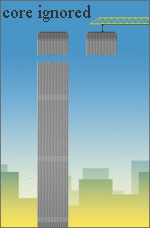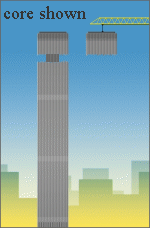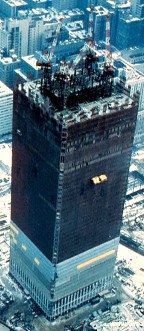Menu
The 'Final' 9/11 Commission Report, released 7/22, is not complete. What about the Pentagon video frames (CNN)? BTW, have you ever seen the unbelievably bogus forged Niger uranium documents? (ABC NBC) 
|
Free-Falling Bodies Simple Physics Reveals The Big Lie "Collapse" Theory Fails Reality Check On September 11, 2001, most of the world watched in horror as the Twin Towers of the World Trade Center (WTC) "collapsed". People did not have to be tuned in at the time in order to have seen it; it was repeated ad nauseam on television for days.
In June 2005, in an apparent response to an article by Morgan Reynolds, Robert Gates, the former Director of the Central Intelligence Agency (CIA) and Well, first of all, the American people saw things not with their own eyes but on television, which is comprised nowadays of digital information, which can be manipulated by computers. So, right off the top, Gates' premise is flawed. And while the towers are gone, people have, both with their own eyes and on TV, seen magic performed before; eyes can be deceived. So let's just examine his other premise: whether or not it is true that people know what they saw. (The following must be said before we can get to the physics.) The government and the media told us what we saw. The government told us that we had witnessed a "gravitational collapse"; what is now referred to as a "pancake collapse". According to the government's, and PBS's, and Popular Mechanics', and Scientific American's theory, airplane crashes and subsequent kerosene (like lamp oil; jet fuel is NOT exotic) fires heated UL-certified structural steel to the point where it was significantly weakened, which is already very difficult to believe, nevermind repeat in an experiment. According to their "pancake" theory, this imagined purported (all the evidence was subsequently illegally destroyed) weakening supposedly caused part of the tower to fall downward onto the rest of the tower, which, we've been repeatedly told, somehow resulted in a chain reaction of lower floors, sequentially, one at a time, yielding to and becoming incorporated into a growing stack of floors falling from above. There are some problems with that theory; it does not fit the observed facts: It cannot account for the total failure of the immense core columns, nor the 'disappearance' of that so-called "growing stack", nor the too-rapid-to-blame-it-all-on-gravity 'collapse' times, nor the huge energy surplus, nor the nanosizes of the 'dust' particles. This article focuses on the third of these mentioned discrepancies, and just scratches the surface of the fourth. (4th and 5th are addressed here) The scientists(?) who concocted what became the official but physically-impossible "pancake" theory made a fatal error: they forgot to check their work! Which is an easy thing to do, even without any physical evidence to forensically examine. Anyone, at any time, can check their work – that incredible Pancake Theory of theirs – using simple, high-school physics! And that's what we're about to do here. We're going to check the work – something every grade-schooler is taught to do – of those "scientists". We will use a simple, unassailable, incontrovertible conservation-of-energy analysis to perform a simple, basic reality check that establishes, once and for all, that the U.S. government, PBS, Popular Mechanics, and Scientific American have grossly misrepresented the true nature of the events of 9/11.
Sir Isaac Newton noticed, centuries ago, that apples fell (down! never up...) from trees. Lots of others, before him, had also noticed this, but none had ever devised a theory of gravity from the observation. Over the years, mankind has learned that the force of gravity comes from an acceleration of known constant magnitude, depending only upon mass and separation. (That doesn't mean we know HOW it works, or WHY, but we have managed to be able to predict its effects with a high degree of precision and an even higher degree of certainty – gravity has always had the same, predictable, effect.) Of course, people didn't figure this stuff out immediately. According to legend, Galileo Galilei used the leaning tower of Pisa to demonstrate that a large ball and a small one (of lesser mass) fell (accelerated) at the same rate. Prior to Galileo, people had just assumed that heavier objects fell faster (much the way mankind had long assumed that the Earth was flat!). So while an object of greater mass will exert more force upon anything which is supporting it against gravity's pull (ie, it's heavier), it does not experience any greater acceleration when gravity's pull is not opposed (ie, when it's falling). Earth's gravity can only accelerate objects downward at one known, constant, maximum rate (1 g). Heavier objects are not accelerated any quicker than are lighter objects, as Galileo demonstrated centuries ago.
From experimentation, it has been discovered that, near the surface of the Earth, Earth's gravity will produce a downward acceleration of 32 feet per second per second. What that means is that an object, after falling one second, will be falling at 32 ft/sec. After the 2nd second, it will be falling at 64 ft/sec. After the 3rd second, it will be falling at 96 ft/sec. And so on. Further, since gravity's acceleration is constant, and it's falling at 32 ft/sec after one second has elapsed, we know that it has averaged 16 ft/sec for the entire distance, which, after one second, is 16 feet. As you might imagine, after quite a few such thought experiments, some simple free-fall equations have been derived which can be used to harness this knowledge via numbers and arithmetic: Velocity = Gravity x Time and Distance = 1/2 x Gravity x Time(squared) So if we want to know how far the object has free-fallen after 3 seconds: Distance = 1/2 x 32 x 9 = 144 feet So after 3 seconds, in Earth's gravity, an object will have fallen 144 feet and will be falling at 96 ft/sec.
OK, we've just solved a simple physics problem! Now let's check our work, using the well-established principle of conservation of energy. We know that energy is neither created nor destroyed, it merely changes forms. If we take the potential (chemical) energy in a barrel of oil and burn it, we get heat energy. When we take refined oil and burn it in our car's engine, we get kinetic (ie, motion) energy (plus some heat; an engine's not 100% efficient). When we use our car's brakes to bleed off some of that kinetic energy (ie, slow down), the energy is converted into heat (the brakes get HOT). In the case of the free-falling body, the two kinds of energy we are concerned with are kinetic energy and potential energy. Examples of potential (gravitational) energy are the water stored way up high in a water tower, or a boulder perched atop a hill. If whatever's holding them up there is removed, they will come down, under the influence of gravity's pull. So, as an object falls, it gives up potential energy for kinetic energy. It turns out that the equation for potential energy is as follows: Potential Energy = Mass x Gravity x Height It turns out that the equation for kinetic energy is as follows: Kinetic Energy = 1/2 x Mass x Velocity(squared) So let's just say, for the sake of simplicity, that our falling object has a mass of 1. (Remember, the object's mass will affect its energy, and its momentum, but not its rate of free-fall.) The potential energy given up by falling 3 seconds (144 ft) is 1 x 32 x 144 = 4608 The kinetic energy gained after falling 3 secs is 1/2 x 1 x 96(squared) = 1/2 x 9216 = 4608 So, all of the available potential energy was converted to kinetic energy. Seeing that energy was, in fact, conserved is how we know that the answer in The Simplest Case, above, was correct. We've checked our work, using an independent analysis, based upon the sound principle of conservation of energy. Now, and only now, we can be certain that our answer was correct.
Air resistance. The free-fall equations reflect a perfect, frictionless world. They perfectly predict the behavior of falling bodies which encounter zero resistance, as in a vacuum. In fact, some of you may have seen a science class demonstration in which the air is pumped out of a tube and then a feather will fall, in that vacuum, as fast as will a solid metal ball. That's how parachutes work: much of the falling object's potential energy gets expended doing the work of pushing a lot of air out of the way in order for the object to fall. As a result, not all of the potential gravitational energy can go towards accelerating the object downward at gravity's maximal rate of 32 ft/sec/sec. In other words, only when there is zero resistance can any falling object's potential energy be completely converted into kinetic energy. Anything which interferes with any falling object's downward progress will cause its acceleration to be reduced from the maximum gravitational acceleration of 32 feet per second per second, as some of gravity's potential energy is consumed doing work overcoming resistance. That's why you may have heard the term "terminal velocity". The free-fall equations predict that a falling object's velocity will continue to increase, without limit. But in air, once a falling object reaches a certain speed, its propensity to fall will be matched by air's resistance to the fall. At that point the object will continue to fall, but its speed will no longer increase over time.
Earth's gravity causes objects to fall. They fall according to precise, well-known equations. The equations assume no (air) resistance. Any resistance at all will cause the object to fall less rapidly than it would have without that resistance. It is that last sentence which bears repeating. There is a maximum possible rate at which objects fall, and if any of gravity's potential energy is consumed doing anything other than accelerate the object downward – even just having to push air out of the way – there will be less energy available to accelerate the object downward, and so that object's downward acceleration will be diminished.
And if an object's downward acceleration is diminished, it will be going slower along the way, and thus it will take longer to fall a given distance.
|
What's Up
WTC Energy Secret 911Gate! WTC explosions video Pentagon Strike video
Dick Cheney:
W.H. Sex Scandal:
Cell Phone Calls From Planes:
The 9-11
Domestic treason
Links |
||
|
|
Free-falling from WTC heights The towers were 1350 and 1360 feet tall. So let's start by using our trusty free-fall equation to see how long it should take an object to free-fall from the towers' former height. Distance = 1/2 x Gravity x Time(squared) or 2 x Distance = Gravity x Time(squared) Time(squared) = (2 x Distance) / Gravity Time(squared) = 2710 / 32 = 84.7
Time = 9.2 So our equation tells us that it will take 9.2 seconds to free-fall to the ground from the towers' former height. Using our simpler equation, V = GT, we can see that at 9.2 seconds, in order to reach the ground in 9.2 seconds, the free-falling object's velocity must be about 295 ft/sec, which is just over 200 mph. But that can only occur in a vacuum. Since the WTC was at sea level, in Earth's atmosphere, you might be able to imagine how much air resistance that represents. (Think about putting your arm out the window of a car moving half that fast!) Most free-falling objects would reach their terminal velocity long before they reached 200 mph. For example, the commonly-accepted terminal velocity of a free-falling human is around 120 mph. The terminal velocity of a free-falling cat is around 60 mph. (source) Therefore, air resistance alone will make it take longer than 10 seconds for gravity to pull an object to the ground from the towers' former height.
On page 305 of the 9/11 Commission Report, we are told, in the government's "complete and final report" of 9/11, that the South Tower "collapsed" in 10 seconds. Here is the exact quote: "At 9:58:59, the South Tower collapsed [sic] in ten seconds". (That's the government's official number. Videos confirm that it was deverticalized unnaturally, if not precisely that, quickly. See for yourself: QT Real)
But as we've just determined, that's free-fall time. That's close to the free-fall time in a vacuum, and an exceptionally rapid free-fall time through air. But any "collapse" would have needed to proceed "through" the lower stories of the tower. Those undamaged floors below the damaged ones would have offered resistance that is thousands of times greater than air. Recall that those lower stories had successfully supported the weight of the tower for 30 years. Air can't do that. Can anyone possibly imagine the supposedly-undamaged lower floors getting out of the way of the upper floors as effortlessly as air would? Can anyone possibly imagine the lower stories slowing any kind of fall of the upper floors less than would, say, a parachute? (And what energy source could have reduced the height of [most of] the columns, top-down, at the same rate?) It is beyond the scope of the simple, but uncontested, physics in this presentation to tell you how long a gravitational collapse through the path of maximum resistance should [sic] have taken. Would it have taken a minute? An hour? A day? Forever? Perhaps. But what is certain, beyond any shadow of a doubt, is that the towers could not have collapsed gravitationally, through intact lower stories, as rapidly as was witnessed on 9/11. Not even close!
Because, as you may recall, not only was much energy expended in causing the observed massive high-speed sideways and even upward ejections, but virtually all the glass and concrete was
In order for the tower to have "collapsed" gravitationally, as we've been told over and over again, in the observed duration, one or more of the following zany-sounding conditions must have been met:
However, none of these physics-violating conditions can be accounted for by the official government conspiracy theory of 9/11, nor by any of the subsequent analyses designed to prop up the official theory of 9/11. Bottom line: the government/PBS/PM/SA explanation for the WTC "collapses" fails the most basic conservation-of-energy reality check. Further, the government/PBS/PM/SA theory does not fit the observed facts; the notion of a "pancake collapse" cannot account for what happened (steel core columns?!). The "pancake collapse theory" explanation is also impossible, and thus totally absurd. It is utterly impossible for a "gravitational collapse" to proceed so destructively through a path of such great resistance in anywhere near free-fall times. This fact debunks the preposterous contention that the observed WTC "collapses" can be blamed solely upon damages resulting from aerial assaults: the unnaturally-brief durations of the highly destructive top-down "collapses" reveal that the towers did not disintegrate because they were coming down, but rather they came down because something [else] was causing them to disintegrate! So, to the extent that people accept the ridiculous "pancake collapse" explanation, Gates' other premise, that people know what they saw, is also incorrect. It is left to the reader to decide if his conclusion, which was based upon two incorrect presumptions, is also flawed. The purported "gravitational collapse" (video) of World Trade Center building 7, which clearly was hit by zero aircraft, and which also catastrophically failed within its own footprint within 1 second of free-fall-time-in-a-vacuum later that same day, similarly fails this same conservation-of-energy analysis. The explanation for how and why so many highly-accredited and credentialed people all so miserably failed to check the "pancake collapse" theory, by giving it this basic reality check, is beyond the scope of this simple physics discussion.
FAQ
|
You can't move your arms though water as fast as you can through just air. And neither can gravity. You can't move your arms through solids as fast as you can through just water. And neither can gravity. So when anybody tells you that gravity can move things through solids as fast as it can through just air, you don't need to be a physicist to know: they are wrong! Tell a friend about this |





![If the tower 'collapsed' [sic], why is there a vertical particle plume, the same height and width as the tower, drifting away from where the tower stood seconds earlier?](images/WTC_aerial_composite_of_Ghost_Tower_remnant+Pyro_Flow.jpg)